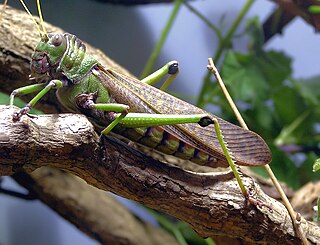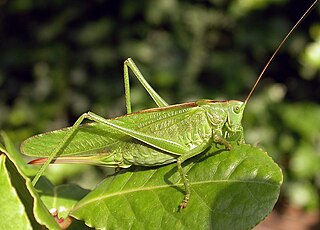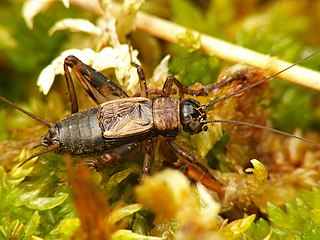Legua is a genus of grasshoppers in the subfamily Romaleinae; described by Walker in 1870.

The Acrididae are the predominant family of grasshoppers, comprising some 10,000 of the 11,000 species of the entire suborder Caelifera. The Acrididae are best known because all locusts are of the Acrididae. The subfamily Oedipodinae is sometimes classified as a distinct family Oedipodidae in the superfamily Acridoidea. Acrididae grasshoppers are characterized by relatively short and stout antennae, and tympana on the side of the first abdominal segment.

The Melanoplinae are a subfamily of grasshoppers in the family Acrididae. They are distributed across the Holarctic and Neotropical realms. They are one of the two largest subfamilies in the Acrididae. As of 2001 the Melanoplinae contained over 800 species in over 100 genera, with more species being described continuously. The genera of the Melanoplinae are classified in 7 tribes, including Conalcaeini, Dactylotini, Dichroplini, Jivarini, Melanoplini, Podismini, and Prumnini.
The Poule d'Essai des Poulains is a Group 1 flat horse race in France open to three-year-old thoroughbred colts. It is run over a distance of 1,600 metres at Longchamp in May.
Jacques Guy Wertheimer was a prominent French-Jewish businessman who inherited and ran the renowned House of Chanel perfume company. Jacques Wertheimer was born at the villa Les Forgettes in Deauville, to a Jewish family, the son of Germaine Revel and businessman Pierre Wertheimer who co-founded the Chanel perfume business in 1924.

The Romaleidae or lubber grasshoppers are a family of grasshoppers, based on the type genus Romalea. The species in this family can be found in the Americas.

The Tettigoniinae are a subfamily of bush crickets or katydids, which contains hundreds of species in about twelve tribes.

The Quitu were Pre-Columbian indigenous peoples in Ecuador who founded Quito, which is the capital of present-day Ecuador. This people ruled the territory from 2000 BCE and persisted through the period known as the Regional Integration Period. They were overtaken by the invasion of the Inca. The Spanish invaded and conquered the center in 1534.

The Cara culture flourished in coastal Ecuador, in what is now Manabí Province, in the first millennium CE.

The subfamily Pseudophyllinae contains numerous species in the family Tettigoniidae, the katydids or bush crickets. Sometimes called "true katydids", together with the crickets of suborder Ensifera, they form part of the insect order Orthoptera which also contains grasshoppers.

Eumastacidae are a family of grasshoppers sometimes known as monkey- or matchstick grasshoppers. They usually have thin legs that are held folded at right angles to the body, sometimes close to the horizontal plane. Many species are wingless and the head is at an angle with the top of the head often jutting above the line of the thorax and abdomen. They have three segmented tarsi and have a short antenna with a knobby organ at the tip. They do not have a prosternal spine or tympanum. Most species are tropical and the diversity is greater in the Old World. They are considered primitive within the Orthoptera and feed on algae, ferns and gymnosperms, the more ancient plant groups.

Nemobiinae is a subfamily of the newly constituted Trigonidiidae, one of the cricket families. The type genus is Nemobius, which includes the wood cricket, but members of this subfamily may also be known as ground crickets or "pygmy field crickets".

Conocephalinae, meaning "conical head", is an Orthopteran subfamily in the family Tettigoniidae.

Morgan Hebard was an American entomologist who specialized in orthoptera, and assembled a collection of over 250,000 specimens.

The Pseudophyllodromiinae are a subfamily of cockroaches, in the family Ectobiidae, with a world-wide distribution.

Romaleinae is a subfamily of lubber grasshoppers in the family Romaleidae, found in North and South America. There are more than 60 genera and 260 described species in Romaleinae.

Proctolabinae is a subfamily of grasshoppers in the family Acrididae. There are more than 20 genera and 210 described species which are found in South America.
James Abram Garfield Rehn was an American entomologist who was a specialist on the New World Orthoptera. He worked at the Academy of Natural Sciences of Philadelphia, making several collection expeditions around the world on their behalf.

Balta is a genus of cockroaches in the sub family Pseudophyllodromiinae. Found in Asia, Africa, Australia and Oceania. The genus was created in 1893 by Johann Tepper.
This page is based on this
Wikipedia article Text is available under the
CC BY-SA 4.0 license; additional terms may apply.
Images, videos and audio are available under their respective licenses.













